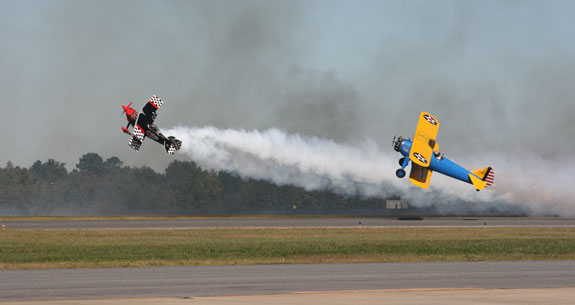
At the 2008 Jacksonville Air Show, the Red Star and the Dragon flew low to the ground in a dogfighting exercise. (Photo by Jonathan Zander.)
By Ralph De La Cruz
Florida Center for Investigative Reporting
There are seven U.S. Navy installations in Florida and five Air Force bases, with a total of more than 50,000 personnel. Add Coast Guard and Reserves, and the number goes up to nearly 110,000.
Florida’s military tradition is as steeped in flying as in ocean steaming. There are naval air stations and air bases from Jacksonville to Pensacola, and south to Key West. When the Cuban Missile Crisis was developing, Homestead Air Force Base — closed in the early 1990s — was the rallying point for military operations. Today, the United States’ Central Command, which has overseen recent military actions in the Middle East, operates out of MacDill Air Force Base in Tampa. And of course, Cape Canaveral is the country’s spaceport.
Not surprising, then, that air shows are as much a part of Florida culture as turtle nesting. Florida will have 18 air shows this year. Only California (27) and Texas (24) will host more.
And the air shows are more than just expressions of American pride. They bring crowds to places such as New Smyrna Beach and Stuart. According to the trade group International Council of Air Shows, people who attend air shows in the United States and Canada spend $110 million. With many of the shows operating out of federal facilities, it’s easy money for the local economy.
And despite the fact that the events involve machines — some 60 or 70 years old — performing intricate and complicated maneuvers while flying at hundreds of miles per hour, it’s relatively safe.
In 2009, there were only two fatalities connected to air shows in the United States and Canada, and zero in 2010. According to the ICAS, there hasn’t been a spectator death at an air show in at least 50 years.
And then came last week, when Jimmy Leeward, a veteran stunt pilot from Ocala, lost control of a plane during an air race at an air show in Reno, Nev. The pilot and eight spectators were immediately killed. Another spectator subsequently died, raising the number of fatalities to 10. The next day, another pilot lost his life at an air show in West Virginia.
The two deadly accidents come on the heels of a spate of air show deaths in August, including the death of Florida pilot Bryan Jensen at the Kansas City Aviation Expo Air Show and a wing-walker in Michigan who lost his grip while trying to transfer from a biplane to a helicopter and fell 200 feet to his death. There was also a deadly crash in Bunnell, Fla., in March at the Second Annual Wings Over Flagler at the Flagler County Airport.
This year, there have been 14 fatalities at air shows. And we’ve got more than three months to go, including November, which is one of Florida’s busiest air show months. There will be five air shows in the Sunshine State that month: MacDill Airfest in Tampa, NAS Jacksonville Air Show, Cocoa Beach Air Show, NAS Pensacola Air Show/Blue Angels Homecoming, and the Stuart Airshow.
What’s going on? Should we be worried? Is there a need for greater regulation? Will potential spectators be scared away by the recent tragedies?
Air show advocates point out that the Reno crash occurred during an air race. Unlike the acrobatic passes at air shows, which are confined to areas well away from crowds, air races use an oval course that goes over the crowd.
That’s why, although there have been numerous calamities involving spectators at European shows, injuries and fatalities at U.S. air shows are typically confined to pilots and participants.
But air show crashes are like shark attacks. Each time one happens, it’s big news. And it leads to a perception that the danger is worse than it really is.
Will these tragedies cause declines in attendance at air shows, adding a little more of a squeeze to local economies?
We’ll soon get the answer on tarmacs at Tampa, Jacksonville, Pensacola, Cocoa Beach and Stuart.
